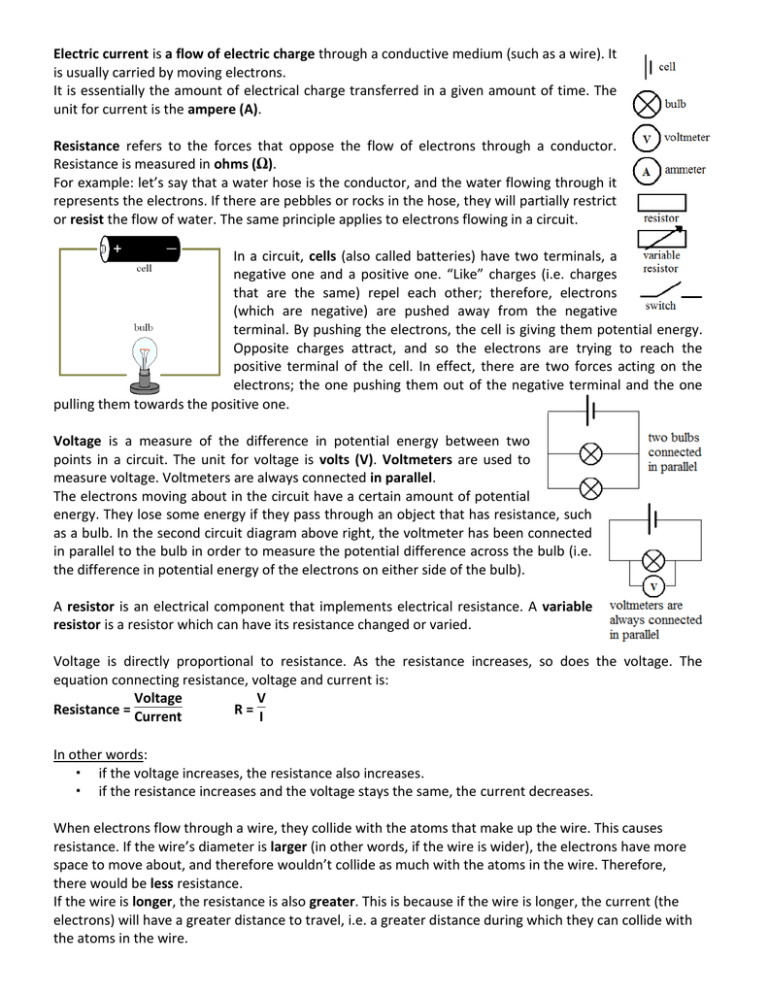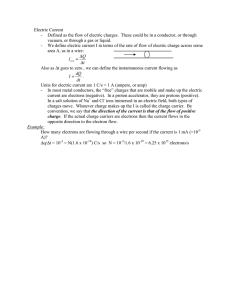Electric current is a flow of electric charge through a
advertisement

Electric current is a flow of electric charge through a conductive medium (such as a wire). It is usually carried by moving electrons. It is essentially the amount of electrical charge transferred in a given amount of time. The unit for current is the ampere (A). Resistance refers to the forces that oppose the flow of electrons through a conductor. Resistance is measured in ohms (Ω). For example: let’s say that a water hose is the conductor, and the water flowing through it represents the electrons. If there are pebbles or rocks in the hose, they will partially restrict or resist the flow of water. The same principle applies to electrons flowing in a circuit. In a circuit, cells (also called batteries) have two terminals, a negative one and a positive one. “Like” charges (i.e. charges that are the same) repel each other; therefore, electrons (which are negative) are pushed away from the negative terminal. By pushing the electrons, the cell is giving them potential energy. Opposite charges attract, and so the electrons are trying to reach the positive terminal of the cell. In effect, there are two forces acting on the electrons; the one pushing them out of the negative terminal and the one pulling them towards the positive one. Voltage is a measure of the difference in potential energy between two points in a circuit. The unit for voltage is volts (V). Voltmeters are used to measure voltage. Voltmeters are always connected in parallel. The electrons moving about in the circuit have a certain amount of potential energy. They lose some energy if they pass through an object that has resistance, such as a bulb. In the second circuit diagram above right, the voltmeter has been connected in parallel to the bulb in order to measure the potential difference across the bulb (i.e. the difference in potential energy of the electrons on either side of the bulb). A resistor is an electrical component that implements electrical resistance. A variable resistor is a resistor which can have its resistance changed or varied. Voltage is directly proportional to resistance. As the resistance increases, so does the voltage. The equation connecting resistance, voltage and current is: Voltage V Resistance = Current R= I In other words: if the voltage increases, the resistance also increases. if the resistance increases and the voltage stays the same, the current decreases. When electrons flow through a wire, they collide with the atoms that make up the wire. This causes resistance. If the wire’s diameter is larger (in other words, if the wire is wider), the electrons have more space to move about, and therefore wouldn’t collide as much with the atoms in the wire. Therefore, there would be less resistance. If the wire is longer, the resistance is also greater. This is because if the wire is longer, the current (the electrons) will have a greater distance to travel, i.e. a greater distance during which they can collide with the atoms in the wire. A current is caused by moving electrons through a wire. Sometimes, the electrons can collide with the atoms in the wire. This causes resistance, which makes it harder for the current to flow; therefore, as resistance increases, current decreases, and viceversa. Ammeters are used to measure the current flowing through a circuit (i.e. they measure amperes or amps). Ammeters need to be connected in series. The resistance of an object (such as a bulb) can be found by using an ammeter and a voltmeter. Set up the ammeter in series to the bulb in order to find the current. Set up the voltmeter in parallel to the bulb to find the potential difference. Then, using the formula R = V/I, divide the voltage by the current. For example, if the current is found to be 15 amps, and the voltage 30 volts, dividing 30 by 15 yields an answer of 2 Ω. ELECTRIC CHARGE Electrostatic electricity is created by loose electrons. For example, if you rub a balloon against a rug or a dry cloth, the balloon will rub some electrons off the cloth and onto the balloon. Therefore, the balloon will have an electrostatic charge on its surface. If you then touch the balloon, you will feel a small electric shock as the electrons pass from the balloon’s surface to your hand. This effect can also be demonstrated by rubbing a balloon against a carpet and then running it under water. Turn the tap on only slightly so that a thin stream comes out. Place the balloon just next to but not touching the stream of water. Water molecules have both a positive and a negative charge on either side of them. The positive charge will be attracted to the electrons, bending the water stream towards the balloon. This video demonstrates the experiment. An electric field is created when an electrically charged object is placed near another charged or polar object, creating a force of electrostatic attraction between the two. In the experiment above, the positive charges in the water are attracted to the negative charges on the balloon. This creates an electric field. Conductors are materials through which an electric current can flow freely. Examples include a lot of metals, such as steel and copper. Good conductors have low resistance. Insulators are materials through which an electric current cannot flow easily. Examples include materials such as wood, plastic, glass and textiles (cloth). Insulators have high resistance. Power is a measure of how much energy is transferred or converted per second. Power is measured in watts (W) (1 watt can also be expressed as 1 joule/second). The formula for power: Power = current * voltage P = IV Energy is a measure of how much work an object can do. The formula for energy: Energy = (current * voltage) * time Energy = power * time



